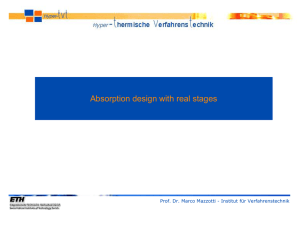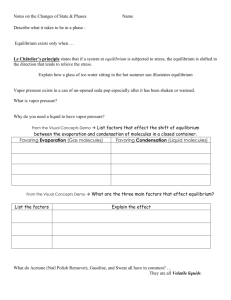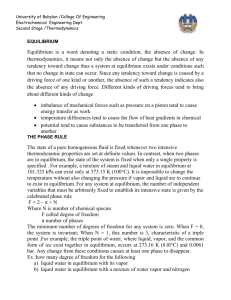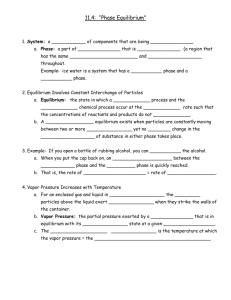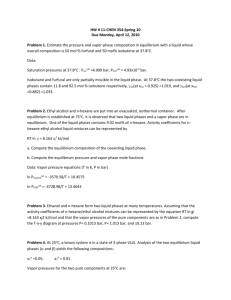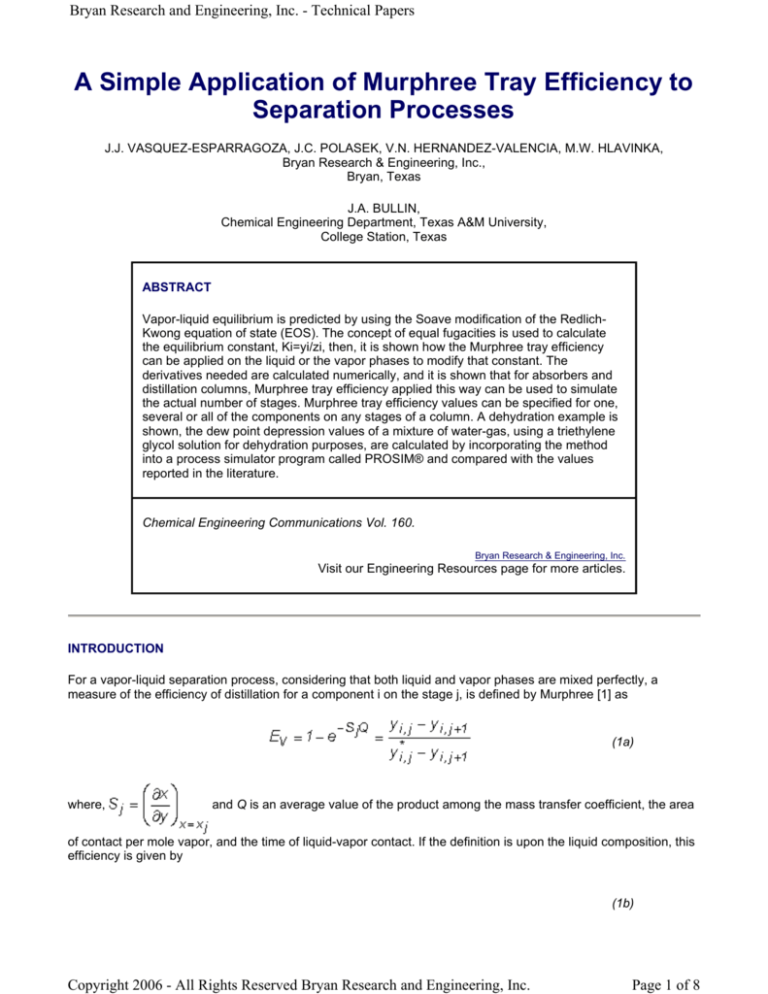
Bryan Research and Engineering, Inc. - Technical Papers
A Simple Application of Murphree Tray Efficiency to
Separation Processes
J.J. VASQUEZ-ESPARRAGOZA, J.C. POLASEK, V.N. HERNANDEZ-VALENCIA, M.W. HLAVINKA,
Bryan Research & Engineering, Inc.,
Bryan, Texas
J.A. BULLIN,
Chemical Engineering Department, Texas A&M University,
College Station, Texas
ABSTRACT
Vapor-liquid equilibrium is predicted by using the Soave modification of the RedlichKwong equation of state (EOS). The concept of equal fugacities is used to calculate
the equilibrium constant, Ki=yi/zi, then, it is shown how the Murphree tray efficiency
can be applied on the liquid or the vapor phases to modify that constant. The
derivatives needed are calculated numerically, and it is shown that for absorbers and
distillation columns, Murphree tray efficiency applied this way can be used to simulate
the actual number of stages. Murphree tray efficiency values can be specified for one,
several or all of the components on any stages of a column. A dehydration example is
shown, the dew point depression values of a mixture of water-gas, using a triethylene
glycol solution for dehydration purposes, are calculated by incorporating the method
into a process simulator program called PROSIM® and compared with the values
reported in the literature.
Chemical Engineering Communications Vol. 160.
Bryan Research & Engineering, Inc.
Visit our Engineering Resources page for more articles.
INTRODUCTION
For a vapor-liquid separation process, considering that both liquid and vapor phases are mixed perfectly, a
measure of the efficiency of distillation for a component i on the stage j, is defined by Murphree [1] as
(1a)
where,
and Q is an average value of the product among the mass transfer coefficient, the area
of contact per mole vapor, and the time of liquid-vapor contact. If the definition is upon the liquid composition, this
efficiency is given by
(1b)
Copyright 2006 - All Rights Reserved Bryan Research and Engineering, Inc.
Page 1 of 8
Bryan Research and Engineering, Inc. - Technical Papers
The above equations represent the change in composition on a stage with respect to that change when there
exists a thermodynamic equilibrium between phases. In the above equations,
and
are the vapor and
liquid composition, respectively, and
,
are the composition of the vapor and liquid phases that would be in
equilibrium with the other phase that actually leaves the stage (stages are numbered from top to bottom).
In general. these efficiencies are less than unity; however, in a big diameter column, the liquid or vapor leaving a
plate has a slightly different composition than the liquid or vapor that reaches the next stage. According to its
definition, this results in an efficiency greater than one hundred percent.
By use of an equation of state to estimate the fugacity coefficients of a mixture in equilibrium, the concept of
equality of fugacities can be modified to include the Murphree type efficiency. For simulation purposes, this
concept is as important as the need of having an actual number of stages in the simulation. A description of how
this method can be applied is presented, and an application example to dehydration units is shown.
BACKGROUND
The Murphree tray efficiency has been used for a long time to relate the theoretical number of stages with the
actual trays in a distillation column or absorber. This efficiency can be based upon the liquid or the vapor
composition on a particular stage at its conditions of temperature and pressure.
Holland and McMahon [2] presented some limitations of the Murphree-type efficiencies. They showed that
efficiencies based on the vapor phase could take on values within the whole range of real numbers. This is
sometimes due to the performance of the efficiency as a deviation of the stage model rather than the degree of
completion of the mass transfer model.
The use of the component Murphree tray efficiency for separation of binary mixtures has been described by
several authors [3, 4, 6, 7]. Some of them show how to use it for multicomponent mixtures. However, a simple
way to apply Murphree tray efficiency to liquid-vapor separation processes has not been shown.
Edmister [7] presented a description of different types and uses of plate efficiencies. A new efficiency was defined
as a multiplier of the absorption or stripping factor on each stage. Takamatsu et al. [8] showed a new solution
process for multicomponent distillation columns. They took the liquid mole fractions to be the independent
variables and their difference between consecutive iterations to be the functions to be zeroed. Their procedure
seems to be stable and fast, and the application of the Murphree efficiency includes a new step in solving the
liquid-vapor composition non-equilibrium equations with a successive substitution method.
In general, the values of the Murphree tray efficiencies are not equal throughout the column. Further, they usually
are not equal for the different components in a mixture, even on the same stage.
When describing a mathematical model of a liquid-vapor separation process, the liquid and vapor phases are
related by the equilibrium constant
, or, in terms of component flow rates
(2)
where x and y are component i liquid and vapor molar compositions respectively, and l and
are component
molar flow rates on each stage, j.
Copyright 2006 - All Rights Reserved Bryan Research and Engineering, Inc.
Page 2 of 8
Bryan Research and Engineering, Inc. - Technical Papers
Using this equation and the vapor Murphree stage efficiency definition in Equation (1a), the resulting equation to
add to the model is
(3)
for each stage j and component i. The efficiencies introduce another n stages by c component equations to the
model, with the efficiencies as variables. However, in order to satisfy the summation of molar composition to be
unity, one of those efficiencies must be dependent. Thus, the problem consists in solving a number of
more equations added to the model system.
Another approach to incorporate the Murphree efficiency into the model is to work with the vapor component flow
rates,
, and the molar compositions, and then normalize the results for the new ones,
.
(4)
where
;
(5)
The approach presented here consists of adjusting the value of the equilibrium constants and keeping the model
equations unmodified. However, some problems can be encountered because of the calculation of a mixture
composition which is not in thermodynamic equilibrium with another mixture (phase). For simulation purposes,
Murphree tray efficiency modifies the equilibrium constants, and changes the internal flow rate in such a way that
the column is always in material balance.
ALGORITHM
A method of predicting liquid-vapor equilibria is to estimate the fugacities of the components in both phases and
compare them until their difference is smaller than a predetermined small value. The most common method to
estimate the fugacities is by use of an equation of state. The basic condition for thermodynamic equilibrium
between two phases states that
(6)
where
represents the fugacity of component i, and the superscripts L and V are used to represent the liquid and
vapor phases respectively.
If the fugacity coefficient is defined as
system, and
, and at equilibrium
, where P is the pressure of the
is the fugacity coefficient of component i with a liquid composition x and vapor composition y,
(7)
Taking logarithms of both sides and rearranging,
Copyright 2006 - All Rights Reserved Bryan Research and Engineering, Inc.
Page 3 of 8
Bryan Research and Engineering, Inc. - Technical Papers
(8)
For a Murphree efficiency based in the vapor phase, the composition
can be calculated by rearranging
equation (1)
(9)
where
is the composition value in equilibrium with the liquid on that stage. Substituting
equilibrium with the liquid phase on stage j (
by its value in
) given by Equation (8) yields
(10)
Equation (10) is used to modify the equilibrium constant of component i on stage j.
The application is simple. Whenever the K value is needed, instead of using the equilibrium constant
, the
used is the one that has been modified by the Murphree tray efficiency. For example, using
the composition in the vapor phase, one obtains a value of
The value of
in equilibrium with
and modifies the value of
by an equation of state or some other means.
by use of the equilibrium equation
is then calculated,
by
(11)
Then, the modified equilibrium constant
(12)
can be used in the model equations. For the liquid composition, the procedure is similar. Calculate the
thermodynamical model, then calculate
with a
to obtain the modified equilibrium constant value by
(13)
where
(14)
If needed, the derivatives can be calculated numerically by use of the modified
Copyright 2006 - All Rights Reserved Bryan Research and Engineering, Inc.
value.
Page 4 of 8
Bryan Research and Engineering, Inc. - Technical Papers
APPLICATIONS
The techniques described in this paper are applied to the definition of the independent parameters and volatilities
described in the "inside-out" methods [9, 10]. These values are functions of the equilibrium constants. The
component molar flow rates are related by
(15)
and the volatility parameters
,
(16)
In other methods, the application would be in the same way. For example, in the 2N Newton-Raphson method [3],
the F functions are defined in terms of the equilibrium constants as
(17)
In using the above model equations, whenever the equilibrium constant,
, is needed, instead of using
(18)
the Ki used is the one that has been modified by the Murphree tray efficiency as described earlier (equations 12
and 13). However, the model equations are not changed.
This method has been implemented in a simulation package called PROSIM® [12], which is a general processes
computer simulator. Table I shows the results of the application of this method to a stand alone absorber (Figure
1) in the service of dehydrating a water saturated gas stream. Stream 1 contains a mixture of methane, 100 lbmol/h (45.4 kg-mol/h) and water, 0.215 lb-mol/h (0.00976 kg-mol/h), at 100oF and 500 psia (37.7oC, 34.5 bar), or
0.0646 lb of water/min (0.0293 kg/min). To obtain a TEG circulation rate of 3 gal/lbH2O (25 l/kgH2O), the number
of gallons per minute needed are (3)(0.0646) = 0.19 SGPM (0.74 SLPM).
Table I. Dew Point Depression values*
Number
of
Actual
Trays
Efficiency
TEG Rate
gal/lbH2O in gas
Figures
20[39-41]**
Murphree
Efficiency
EV,H O = 0.60
2
Ideal
Stages****
oF (oC)
***EV
oF (oC)
oF (oC)
(l/kgH2O)
Composition
Weight %
TEG
4
3 (25.0)
98.5
57 (31.6)
0.54
61 (33.8)
70 (38.8)
4
4 (33.3)
99.0
66 (36.6)
0.57
68 (37.7)
79 (43.8)
4
5 (41.7)
99.5
77 (42.7)
0.63
74 (41.1
95 (50.5)
4
6 (50.0)
99.9
88 (48.8)
0.63
84 (46.6)
129 (71.6)
6
3 (25.0)
99.9
94 (52.2)
0.55
102 (56.6)
129 (71.6)
6
4 (33.3)
99.5
88 (48.8)
0.60
88 (44.8)
95 (52.7)
8
2 (16.6)
98.5
66 (36.6)
0.43
69 (38.3)
71 (39.4)
Copyright 2006 - All Rights Reserved Bryan Research and Engineering, Inc.
Page 5 of 8
Bryan Research and Engineering, Inc. - Technical Papers
8
3 (25.0)
99.5
90 (50.0)
0.55
92 (51.1)
95 (52.7)
8
6 (50.0)
99.9
124 (68.8)
0.61
123 (68.3)
129 (71.6)
* as calculated using PROSIM
** from reference 11
*** value of EV (for all components) used to match the values of previous column
**** depression value obtained when EV = 1.00
FIGURE 1
The conditions are taken from Figures 20[39-41] in the Engineering Data Book [11]. The table shows the actual
number of stages and the values of the dew point depressions given by an absorber with ideal stages. Also
shown are the values of the Murphree tray efficiencies used to match those points. Additionally, Table I shows the
values of the dew point depression obtained when a value for the Murphree tray efficiency of 60% was applied
only to water. In both cases, the inside-out algorithm was used to model the absorbers. As can be seen, the
values shown agree with the values from the chart.
Figure 2 shows the liquid-vapor equilibrium composition for a mixture of benzene-toluene at 1 atm of pressure. It
also shows the operating lines and the number of ideal stages (10 total, including total condenser and reboiler)
needed to separate a mixture of 50 mole % benzene, to a top product specification of 95 mole % benzene. By
applying the efficiency to the well known graphical McCabe-Thiele technique, one can conclude that for a 50%
stage efficiency, approximately 15 real stages are needed to complete the separation. Figure 3 shows the results
of simulating the same column using PROSIM with 15 stages and 50% efficiency. A good agreement with the
graphical procedure was found. For simulation purposes, condensers, reboilers and plates considered as
equilibrium flash stages always have efficiencies of 100%.
FIGURE 2
CONCLUSIONS
A simple method for applying the Murphree stage efficiency is presented. This method can be used with any
thermodynamic model. In some cases, the method presented slight stability problems, particularly in finding a
good initial guess to start the solution procedure when applying a stage efficiency (same efficiency for all
components). This problem was solved by using the 100% efficiency of the same case, as the initial guess for a
different efficiency value, or by running 2 or 3 iterations with an efficiency value of 100% before applying the
specified value. In general, the stability problem was not encountered when using component efficiencies.
It was noted a component that might give some stability problems is the one whose composition does not change,
or has a minimum variation through the column. If, for example, the composition
is equal to
, the
Murphree efficiency approaches zero. On the other hand, if the equilibrium value
is equal to
, the
efficiency becomes undefined ( ). A solution of this is to set the efficiency to be 100% for that particular
component.
For simulation purposes, this technique shows a good way to deal with the problem of real or actual stages in a
distillation column. For glycol dehydration units, it was found that a Murphree tray efficiency value within the range
of 45-65% can be used to simulate the actual number of stages (where the overall efficiency is within 30-40%).
ACKNOWLEDGEMENT
The authors would like to thank Bryan Research & Engineering, Inc. for granting permission to publish this paper.
Copyright 2006 - All Rights Reserved Bryan Research and Engineering, Inc.
Page 6 of 8
Bryan Research and Engineering, Inc. - Technical Papers
NOMENCLATURE
c
number of components
Murphree stage efficiency based upon liquid composition
Murphree stage efficiency based upon vapor composition
EOS
F
equation of state
set of functions defined by Equation (17)
fugacity of component i
K
equilibrium constant
liquid flow rate of component i on stage j
n
P
Q
number of stages
pressure
average product of mass transfer coefficient, area of contact
per mol vapor and time of contact
derivative of the equilibrium curve at
SGPM
TEG
standard gallons per minute
triethylene glycol
vapor flow rate of component i on stage j
x
y
Greek Letters:
liquid composition
vapor composition
volatility parameter defined in Equation (16)
fugacity coefficient of component i
Subscripts:
i
j
mod
L
V
Superscripts:
L
V
*
component i
stage j
modified equilibrium value
liquid
vapor
liquid
vapor
equilibrium value
REFERENCES
1. Murphree, E. V., "Rectifying Column Calculations – With Particular Reference to N Component Mixtures,"
Industrial and Engineering Chemistry, 17 (7), 747-750(1925).
2. Holland, C. D., and K. S. McMahon, "Comparison of Vaporization efficiencies with Murphree-type efficiencies in
Copyright 2006 - All Rights Reserved Bryan Research and Engineering, Inc.
Page 7 of 8
Bryan Research and Engineering, Inc. - Technical Papers
distillation – I," Chemical Engineering Science, 25, 431- 436(1970).
3. Holland, C. D., Fundamentals of Multicomponent Distillation, McGraw Hill, N.Y., (1981).
4. Hines, A. L., and R. N. Maddox, Mass Transfer Fundamentals and Applications, Prentice-Hall, N.J., (1985).
5. King, C. J., Separation Processes, McGraw Hill, N.Y., (1981).
6. Van Winkle, M., Distillation, McGraw Hill, N.Y., (1967).
7. Edmister, W. C., "Hydrocarbon absorption and fractionation process design methods. Part 18 - Plate
Efficiency," The Petroleum Engineer, January, C-45(1949).
8. Takamatsu. T., and M. Kinoshita, "A Simulation Procedure for Multicomponent Distillation Columns
Incorporating Plate Efficiencies," Journal Chem. Eng. of Japan, 18(1), 78-81(1985).
9. Boston, J. F., and S. L. Sullivan, Jr., "A New Class of Solution Methods for Multi-component, Multistage
Separation Processes," The Canadian Journal Of Chemical Engineering, 52, 52-63(1974).
10. Russell, R. A., "A Flexible and Reliable Method Solves Single-tower and Crude-distillation-column Problems,"
Chemical Engineering, October, 53-59(1983).
11. Gas Processors Suppliers Association, Engineering Data Book, Vol. II, Tenth Edition, (1987).
12. PROSIM, Bryan Research & Engineering, Inc., General Purpose Simulator, Bryan, TX(1995).
copyright 2001 Bryan Research & Engineering, Inc.
Copyright 2006 - All Rights Reserved Bryan Research and Engineering, Inc.
Page 8 of 8

